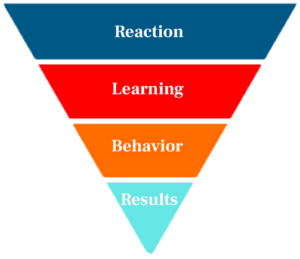Written by Kristen Stevenson, ABD
Organizations increasingly invest in employee training and development to remain relevant. However, the question remains: how do we measure the actual impact of these training programs on business outcomes? Evaluating training effectiveness is essential for ensuring return on investment (ROI) while aligning employee skills with the organization’s strategic goals. Let’s learn more about the importance of measuring training initiatives, explore various methods and metrics for evaluation, and highlight the benefits of a well-structured, data-driven approach (Continu Team, 2023).
Training programs can be costly and time-consuming, making it imperative for businesses to evaluate the effectiveness of their initiatives. Decision-makers must consider if the current training meets the organization’s needs, if it needs to be repurposed, or to start fresh. This consideration is investigated by considering whether the return on investment (ROI) demonstrates a greater financial return from the training than the costs incurred. This can be tricky, though, because training programs can be expensive and use outcomes that are difficult to track.
The first step to determining if training meets your organization’s needs is to ensure that the outcomes are measured, reviewed, and aligned with the strategic objectives. This can be a time-consuming process, but it promotes an environment in which your workforce is adept at fulfilling current and future needs (Rudy, 2023). Ultimately, you need to ask, does the training improve employee performance and productivity?
Asking this question gives you the impetus to evaluate your current training to identify the strengths and weaknesses in your organization. This information can guide improvements, ensuring that training evolves with the business’s and the market’s needs. Be honest in what you see as the true strengths in your team and areas that can be improved for the betterment of the whole.
Measuring impact can help discover how training contributes to job satisfaction and retention rates. Ultimately, employees participating in effective training programs are more likely to feel valued and engaged. Organizations can foster a culture that prioritizes continuous learning and improvement by consistently measuring and reviewing training impact.
Metrics and Methods for Evaluation
Several frameworks and methods can be deployed to measure the impact of training on business outcomes. Here are some practical approaches.
Kirkpatrick Model

This classic model evaluates training effectiveness through four levels:
- Reaction: Measure how your employees feel about the training. This can include surveys assessing satisfaction and relevance.
- Learning: Evaluate what your team has learned. This can be done through tests, assessments, or practical demonstrations.
- Behavior: Observe changes in behavior on the job. This often involves feedback from peers and supervisors or performance reviews.
- Results: Assess the overall business impact of the training. Metrics can include sales figures, productivity rates, and employee retention.
ROI Analysis
ROI analysis is a powerful method, but it requires accurate data on training costs and the concrete benefits it delivers. Calculating ROI considers the financial return from the training compared to the costs (Seymore, n.d.).

Consider a scenario where a company invests $30,000 in a 100-day training program for 30 call center agents.
- Before the training, each agent manages 20 calls per hour. After completing the program, their capacity increases to 25 calls per hour, reflecting a 25% boost in productivity.
- With an average cost of $1 per call, the additional five calls handled per hour generate an extra $5 in value per agent. Over an 8-hour workday, this translates to $40 per agent.
- For all 30 agents, the total daily benefit amounts to $1,200. Over the entire training period, this benefit accumulates to $120,000.

Key Performance Indicators (KPIs)
Identify specific Key Performance Indicators (KPIs) that align with training objectives. For example, if training aimed to increase sales, relevant KPIs could include:
- Sales conversion rates
- Customer satisfaction scores
- Time is taken to close sales leads
Monitoring these KPIs before and after training can provide insights into their impact.
Surveys and Feedback
Collecting qualitative feedback from your employees post-training provides valuable insights. Surveys can include open-ended questions that allow employees to detail their experiences and suggest improvements.
Performance Appraisals
Integrating training evaluations into regular performance management systems can facilitate ongoing assessment. Managers can track employee performance metrics and associate changes with the training received.
Best Practices for Measuring Training Impact
To ensure the effectiveness of your training evaluation processes, consider the following best practices.
- Set Clear Objectives: It bears repeating that you must begin with clear, measurable objectives before implementing any training program. Spending time at the outset to gain clarity will facilitate a more effective assessment later.
- Use a Combination of Methods: No single measurement approach will capture the complete picture of training impact. Utilize a combination of metrics, like surveys, performance evaluations, and KPIs, for a comprehensive review.
- Involve Stakeholders: Engaging various stakeholders, including employees, managers, and HR professionals, can enhance the relevance of the evaluation process. Their input will provide a well-rounded view of training effectiveness.
- Create a Feedback Loop: Encourage a culture of feedback where employees can suggest changes based on their training experiences. This openness can lead to more effective programs and enhance engagement.
- Review and Adapt: Regularly review training programs and the associated measurement methods. Adapting to emerging business needs, workforce changes, and technological advances will maintain the relevance and effectiveness of training initiatives.
The Benefits of Measuring Training Impact
Investing time and resources into measuring the impact of training can yield numerous benefits for organizations. With comprehensive data on training impact, organizations are better positioned to make informed decisions regarding future training investments.
You will see improved employee performance once you understand what works and what doesn’t so that you can tailor training experiences, resulting in enhanced performance. Training initiatives aligned with business objectives can reduce costs, optimize processes, and improve productivity.
When employees see that their training is directly tied to their performance and the organization’s success, it fosters a positive attitude and motivates engagement. This commitment to measuring training impact contributes to a culture of accountability, continuous improvement, and skill development.
Support Where You Need It
It is often overwhelming for thought leaders to evaluate their current training practices, revise as necessary, and create new content to address rapidly changing industries. With over 200 years of combined experience in learning and development, the team at eLearningDOC helps you navigate the uncertainty of creating new objectives, outcomes, and meaningful employee training that will improve your ROI and KPIs. If you are unsure where to start, contact us to see how we can help you!
Conclusion
Measuring the impact of training on business outcomes is not just an optional component of employee development; it is a strategic necessity. It ensures that training investments are justified, aligned with organizational goals, and able to adapt to changing needs. By employing robust evaluation methods and maintaining a commitment to continuous improvement, businesses can reap the full benefits of their training programs, ultimately leading to enhanced employee performance and organizational success. Investing in training is essential, but understanding its impact drives business forward.
References
Continu Team. (2023, August 23). How to calculate and measure the ROI of training. Continu.
Rudy, B. C. (2023, October 16). Evaluating ROI on your company’s learning and development initiatives. Harvard Business Review.
Seymore, S. (n. d.). Measuring the ROI of your training initiatives. SHRM LABS.









